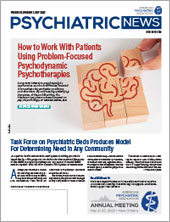A computer-simulation model for assessing the need for psychiatric beds in any community has been developed by the APA Presidential Task Force on Assessment of Psychiatric Bed Needs in the United States.
The model, which will be continually refined, can predict how changes in any component of mental health care in a community—mobile trauma teams, assertive community treatment, residential services, inpatient beds—will impact other components and the overall capacity to care for people with mental illness.
The model is described in a new report issued at APA’s 2022 Annual Meeting, “The Psychiatric Bed Crisis in the U.S.: Understanding the Problem and Moving Toward Solutions.” The task force, chaired by past APA President Anita Everett, M.D., was appointed by then APA President Jeffrey Geller, M.D., M.P.H. It comprised more than 30 APA leaders, mental health professionals who are experts in health services and population health, and members of the APA administration.
In a session about the report in New Orleans, Everett provided an overview of the work and goals of the task force and the complexity of developing a tool that takes into account multiple levels of mental health care in a fragmented system. Although the model is still being refined, the task force is seeking community leaders who may be interested in testing it.
Everett was joined by Kristen Hassmiller Lich, Ph.D., an associate professor of health policy and management at the University of North Carolina School of Global Public Health. She chaired a subgroup of the task force with expertise in statistics and systems modeling. Hassmiller Lich provided a visual display of the computer simulation that demonstrated the power of the model to predict how changes in any aspect of mental health care in a system affect all other aspects of the system and ultimately affect the community’s ability to care for its population of people with mental illness.
She explained that the model was built on four basic questions: How do people enter the system of mental health care? How do people get routed to appropriate services? How long does the service take (how long are people in the system)? How much capacity exists? From these questions a “virtual world” was built with the following components of care: mobile crisis teams, intensive team-based outpatient care, community-based crisis beds, psychiatric hospital beds, and residential and step-down programs.
“What we wanted to do is build a model that can support learning, engagement, and discussion among leaders and policymakers in communities,” said Hassmiller Lich. “It can allow community leaders to test different alternatives and ask ‘what if’ questions: What if we increase the number of mobile crisis teams attempting to stabilize as many people as possible and leveraging community resources? The model might show that we would dramatically reduce boarding [in emergency departments] and the number of individuals who are arrested. Inpatient bed utilization falls some, but still hovers around 90%. If we increase the number of inpatient beds, we might dramatically reduce the number of individuals that end up arrested, we can unclog the waiting lines, and people can get into some sort of point of care faster.
“Ultimately, the model can help us get a better idea of what it would look like if our system was functioning in its best form.”
During the discussion after the presentation, former APA President Steven Sharfstein, M.D., who served on the work group on the history and contemporary uses of psychiatric beds, said the model can also be used “reactively” as a tool in advocacy to demonstrate what will happen when services are cut.
“Sadly, this is what is happening with resource constraints,” said Sharfstein, who was head of the Sheppard Pratt Health System for many years and instituted major innovations to serve more people with mental illness. “If a general hospital closes its 10-bed psychiatric unit, or a major psychiatric emergency room shuts down, or if a mobile crisis team is defunded, what’s that going to do to the rest of the system? This model can be really useful in the political marketplace.”
APA CEO and Medical Director Saul Levin, M.D., M.P.A., saluted Geller and Everett, saying the model has the potential to help communities think creatively about addressing the mental health care crisis.
“If we can’t get services for someone in an acute crisis, we really need to worry about where we are in psychiatry. And if someone needs to travel four hours to find a hospital bed for a loved one—this is not what this country should be.” ■
An in-depth article on the report will appear in the August issue.
